
Hunting is a pursuit that demands precision, skill, and a deep understanding of the game being pursued. Shot placement is a critical aspect of successful hunting, and in the context of a hunt in South African, few species are as revered and challenging to hunt as the kudu. This article will look into the crucial topic of where to place shots on kudu, providing hunters with the knowledge they need to make ethical, humane, and effective shots.
Key Takeaways
Ethical Imperative
- Correct placement of your shot is not just a skill but a moral imperative for responsible hunters. Ensuring humane, one-shot kills is essential.
Precision is Paramount
- Achieving precision accuracy and where shots are placed is crucial for hunters. Understanding the kudu’s anatomy and vital organ locations is fundamental for success.
Adapt to Your Weapon
- Different hunting methods, such as rifle, bow, and muzzleloader hunting, require subtle adjustments in shot location due to variations in range and projectile speed.
Practice Patience and Positioning
- In various shot scenarios, patience and proper positioning are key. Waiting for the right moment and positioning yourself for the most effective shot is critical.
Responsible Hunting
- Responsible hunting includes being a steward of the environment. Reducing waste, respecting game laws, and minimizing your impact.
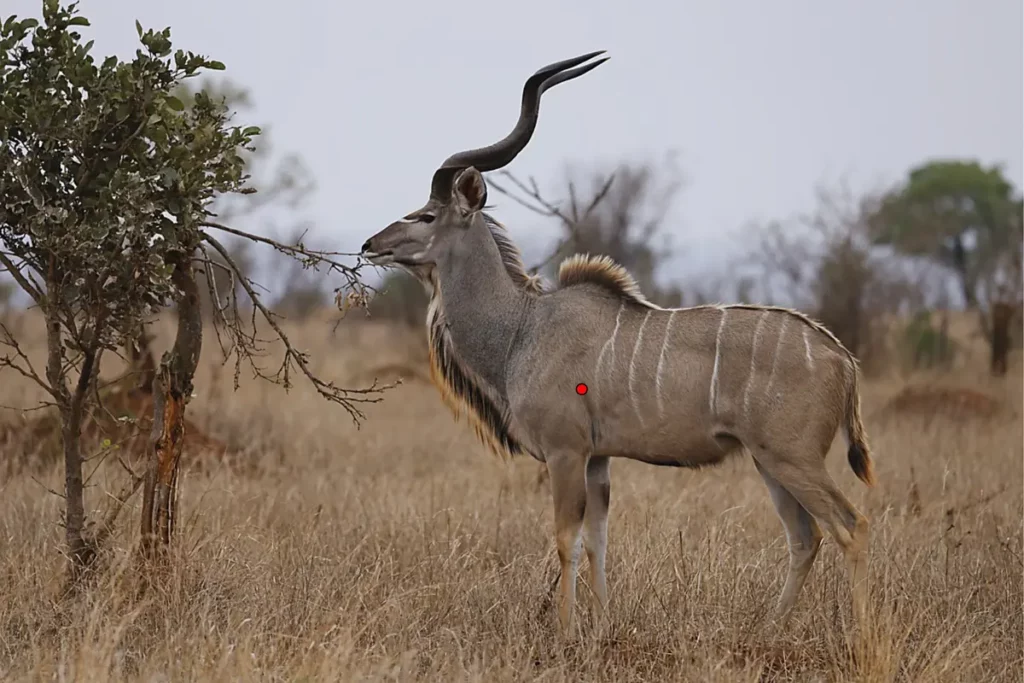
Importance of Shot Placement in Hunting Kudu
Accurate shooting is not merely the mark of a skilled hunter, it is also the key to ethical hunting. A well-placed shot ensures a clean, quick kill, minimizing the suffering of the animal. In the case of a kudu trophy, this is of utmost importance. The kudu is known for its resilience and the ability to cover considerable distances even after being wounded. It is our ethical duty as hunters to strive for one-shot kills, reducing any unnecessary suffering.
Overview of Kudu in South Africa
The kudu (Tragelaphus strepsiceros) is an iconic African antelope species and a prized trophy for hunters. It’s known for its striking, spiraled horns and elegant appearance, making it a sought-after target for many hunters visiting South Africa. Kudu hunting provides a unique challenge due to their elusive nature and their ability to blend seamlessly into their natural habitat. Kudus are often referred to as the “Grey Ghosts” due to their exceptional camouflage abilities and elusive behavior. In South Africa we have the slightly smaller Eastern Cape Kudu and the Southern Greater Kudu. Understanding their anatomy is the first step to a successful hunt.
Understanding Kudu Anatomy
To make an accurate and ethical shot on a kudu, hunters must have a solid grasp of the animal’s physical characteristics and the placement of vital organs. Here’s an overview:
Description of Kudu’s Physical Characteristics
Kudus are large antelopes with long legs, a brown to grayish-brown coat, and distinctive white vertical stripes along their body. Males, known as bulls, bear the impressive, corkscrew-shaped horns, which can reach lengths of up to 60 inches or more. Their mane is shaggy and hangs from their neck to their chest, they have a white chevron on front of their faces. Kudu females, known as cows, lack horns and are generally smaller than mature bulls.
Vital Organs and Their Placement in the Body
Understanding where to place your shot is critical for a humane and efficient kill. The vital organs in a kudu are situated in the chest cavity, slightly behind the front leg. The heart and lungs are the primary targets for a clean kill. The heart is typically situated low in the body and right behind the front leg in the lower third of the chest. Lung placement is similar, occupying the mid to upper portion of the chest cavity.
This knowledge will enable hunters to make informed decisions in the field and increase their chances of a successful kudu hunt.
Factors to Consider for Effective Shot Placement
Effective placement of your shots is not solely about making an accurate shot; it’s about ensuring quick, ethical kills. Several crucial factors must be considered when aiming for the perfect shot.
Importance of Placement for Quick and Ethical Kills
Quick, ethical kills are the primary goal of every responsible hunter. By targeting vital organs, we can achieve this goal. When you strike the heart or lungs, the animal typically experiences rapid loss of consciousness and blood pressure, leading to a fast, one-shot kill.
Factors to Consider, Distance, Angle of Shots in Relation to Vital Organs
Distance
The distance between you and the kudu plays a critical role in where to shoot. As the distance increases, your shot’s accuracy and hitting power may decrease. It’s important to gauge your shooting skills and the capabilities of your firearm or bow. Kudu are known for their sharp senses, and stalking to get within an effective shooting range is often necessary.
Angle
The angle at which the kudu presents itself is another crucial factor. Different shot angles require adjustments in your aim to ensure the projectile reaches the vital organs. It’s important to practice these angles and understand how they affect your shot.
Placing the Shot in Relation to Vital Organs
As previously mentioned, the heart and lungs are the primary targets for an ethical kill. Understanding the precise location of these organs within the kudu’s chest cavity is essential. A shot placed just behind the leg and at the top for the lower third of the chest is ideal. When considering distance and angle, ensure that your shot trajectory intersects with this vital area.
Kudu Shot Placement
Now, let’s explore various different hunting scenarios. Take a look at the shot placement diagrams for reference. The technique you use will depend on the kudu’s position and angle. Avoid head and neck shots as these small targets often result in heart ache or a ruined cape. When the right opportunity presents it’s self don’t hesitate in taking the shot:
Broadside Shot
When a kudu presents a side on view, it offers an excellent shot opportunity. Aim for the region just behind the front shoulder and a third of the way up the body. This position provides a clear path to the heart and lungs.
For a broadside shot on a kudu, your goal is to make a precise shot that ensures a quick and ethical kill. When the kudu is standing side on to you, your target area is the region just behind the front leg and roughly midway up the body. The importance of hitting the vital organs cannot be stressed enough in this scenario. Aim for the vital triangle, as the heart or lung shot is extremely effective.
If using a firearm, a well-placed shot in this region is likely to penetrate the chest cavity and reach the heart and lungs, and will result in the death of the animal. When bowhunting, the goal remains the same – aim for the same area, just behind the shoulder and slightly above the lower third of the chest. A well-placed arrow will have the same effect, causing the kudu to expire swiftly.
Quartering-Away Shot
In a quartering-away position, your target is angled slightly away from you. Aim for the fore leg on the offside shoulder. This shot maximizes your chances of hitting the vitals and achieving a clean kill.
A quartering-away shot occurs when the kudu is facing away from you at an angle. This shot can be highly effective if executed correctly. To position yourself for a successful quartering-away shot, it’s crucial to take your time and wait for the right moment. When the kudu presents this angle, aim for the the fore leg on the side farthest from you.
The key to a successful quartering-away shot is to reach the vital organs – the heart and lungs. If the kudu is slightly angled away, your shot can have a clear path to these organs. When using a firearm, aim for your shot to exit on the off side shoulder, and a third of the way up the body. In bowhunting, the target area remains the same. Patience and proper positioning are critical for achieving a clean kill in this scenario.
Quartering-Towards Shot
A quartering-towards shot presents challenges and risks due to the angle of the kudu’s body. This angle can lead to non-fatal hits if not executed properly. When the kudu is quartering towards you, it’s essential to be cautious. The target area is the inside of the shoulder on the side closest to you.
To ensure an ethical kill, aim to impact just inside the shoulder closest to you with the intention of missing the shoulder bone and penetrating the chest cavity. This shot will prevent the bullet or arrow from merely passing through muscle and skin, which can result in non-fatal hits. Remember, this shot is best avoided when a more ideal angle may be presented.
Frontal Shot
A frontal shot is considered high risk and should only be taken when no other shot is available. In a front on shot, the kudu is facing directly towards you, minimizing the target area and making the vitals challenging to reach. The goal is to aim for the center of the chest, just below the neck.
The risk with a front on shot is that the shoulder bones can obstruct the shot’s path to the vital organs. To improve your chances of a clean kill, aim slightly below the neck, focusing on missing the shoulder bone to reach the chest cavity. However, this shot should be a last resort, as it carries a higher risk of non-fatal hits.
Mastering these shooting angles and techniques will significantly improve your success as a kudu hunter. We will discuss recommended calibers and shot locations in various hunting scenarios, ensuring that you have the knowledge and skills to ethically and effectively harvest this majestic species.
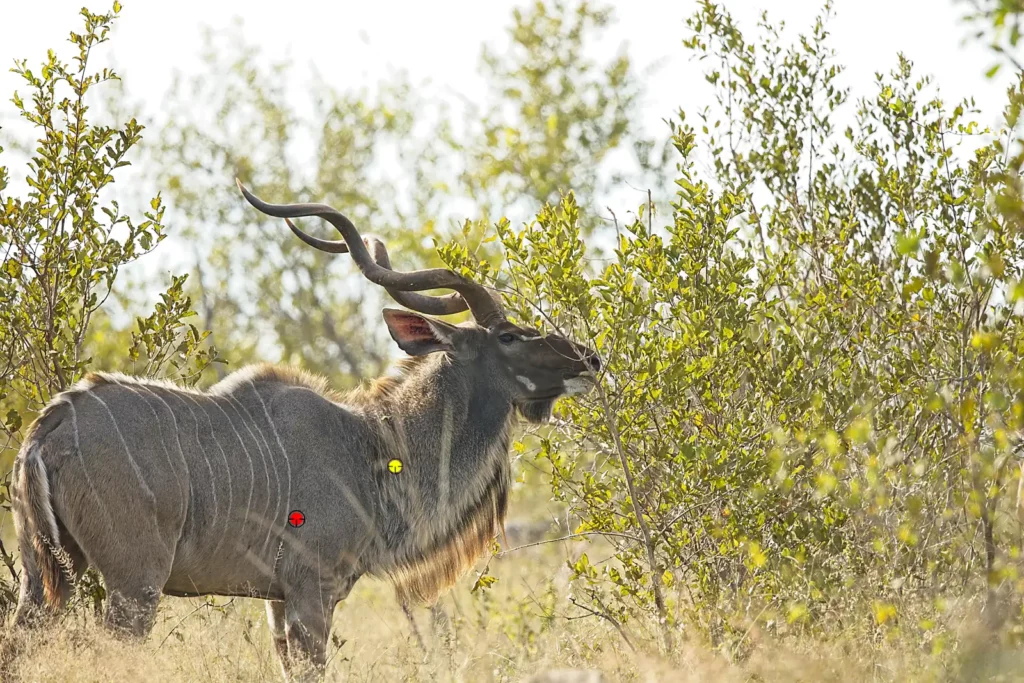
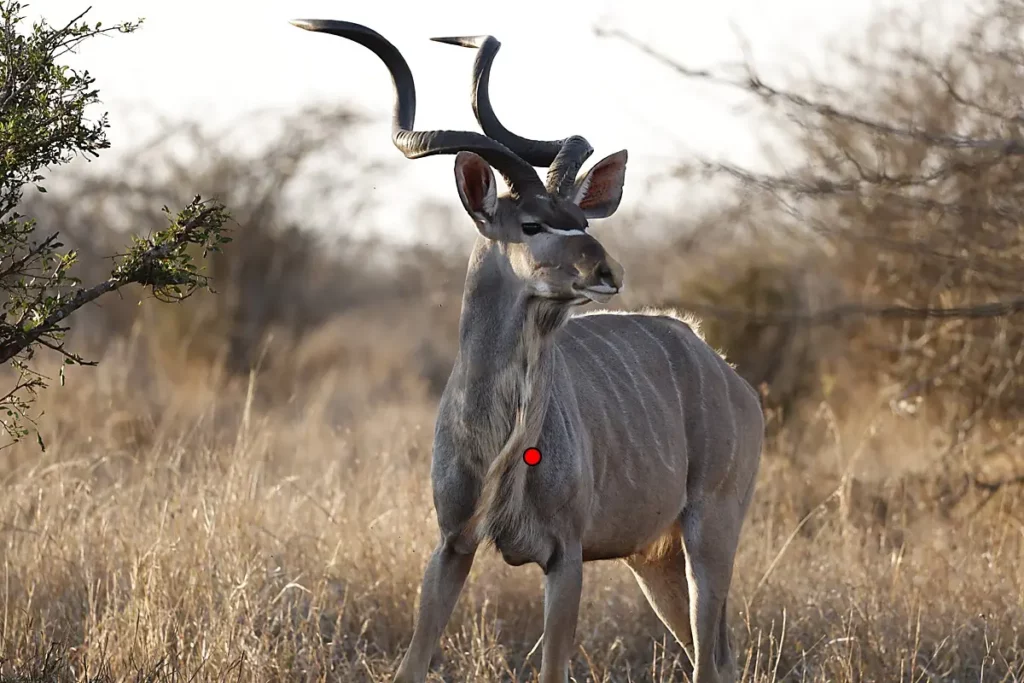
Considerations for Different Hunting Safaris
Mastering shot placement on African game varies depending on the hunting method employed. Whether you’re rifle hunting, bow hunting, or using a muzzleloader, it’s crucial to understand the unique factors associated with each method and how they impact where you shoot.
Rifle Hunting
Rifle hunting allows for longer-range shots with greater accuracy. When rifle hunting a kudu bull, the key is precision. The ideal shot location remains behind the shoulder, aiming for the region just behind the fore leg and midway up the body to reach the heart and lungs. The impact of a high heart shot is devastating and results in quickly dispatching the animal, making it essential to have a steady rest and a firearm suited for the task. Ideal rifles and calibers for Kudu are the 270 Win, 308 Win, 30-06 Springfield, 9.3 X 62 and the 375 H&H. These rifle calibers with heavy for caliber bullets in the 180 to 250 gr range will perform well if shots are placed correctly. A rifle scope of 3-9 X 40 or 4 -12 X 50 is the perfect choice to shoot a Kudu.
Bowhunting
Bowhunting presents a distinct set of challenges due to its shorter effective range and the slower speed of arrows compared to rifle bullets. For kudu bow hunting, it’s crucial to be closer to the animal, ensuring a higher likelihood of well placed shots and a clean kill. The target area is just behind the fore leg and slightly above the lower third of the chest from the bottom of the brisket. Bow hunters must focus on stealth and perfect positioning to ensure their shot reaches the vital organs effectively. The ideal bow setup for Kudu is a minimum draw weight of between 60 to 70 pounds with an arrow weight of around 450 to 500 grains, tipped with razor sharp broad heads.
Muzzleloader Hunting
Muzzleloaders are firearms that require more time to reload between shots. When hunting a big kudu with a muzzleloader, patience is key. Shot location is similar to rifle hunting, targeting the heart and lungs in the chest area just behind the fore leg. Muzzleloader hunters must be confident in their shot, as they have limited opportunities for follow-up shots.
Understanding the nuances of placing your shot for each hunting method is vital for hunters to adapt to the specific challenges presented by their chosen tool.
Ethics and Responsibility on a Kudu Hunt
The ethical aspect of shooting cannot be overstated. Responsible hunting practices dictate that hunters strive for clean and humane kills. Ethical hunting extends beyond the act of hunting itself; it involves a profound respect for the animals pursued and the environment in which the hunt takes place.
Hunters should prioritize:
Humane Kills
- The primary goal of your shot is to ensure a swift and humane kill. This minimizes suffering and demonstrates respect for the animals we hunt. Listen to the advice of your Professional Hunter.
Respect for Game Laws
- Ethical hunters always operate within the law, following hunting regulations and seasons to maintain the sustainability of wildlife populations.
Sound Judgement
- Knowing your own limits and the limits of your equipment is essential. Never take shots that are beyond your skill level or your weapon’s effective range.
Conservation of the Environment
- Responsible hunting practices involve respecting the bushveld and minimizing our impact on the environment.
Ultimately, an ethical shot is a reflection of a hunter’s commitment to good hunting. Striving for the highest standards of responsibility, respect, and compassion is not just an expectation; it’s a fundamental aspect of the hunting community’s ethos. By adhering to these principles, hunters can enjoy their pursuit while contributing to the preservation of wildlife and their habitats.
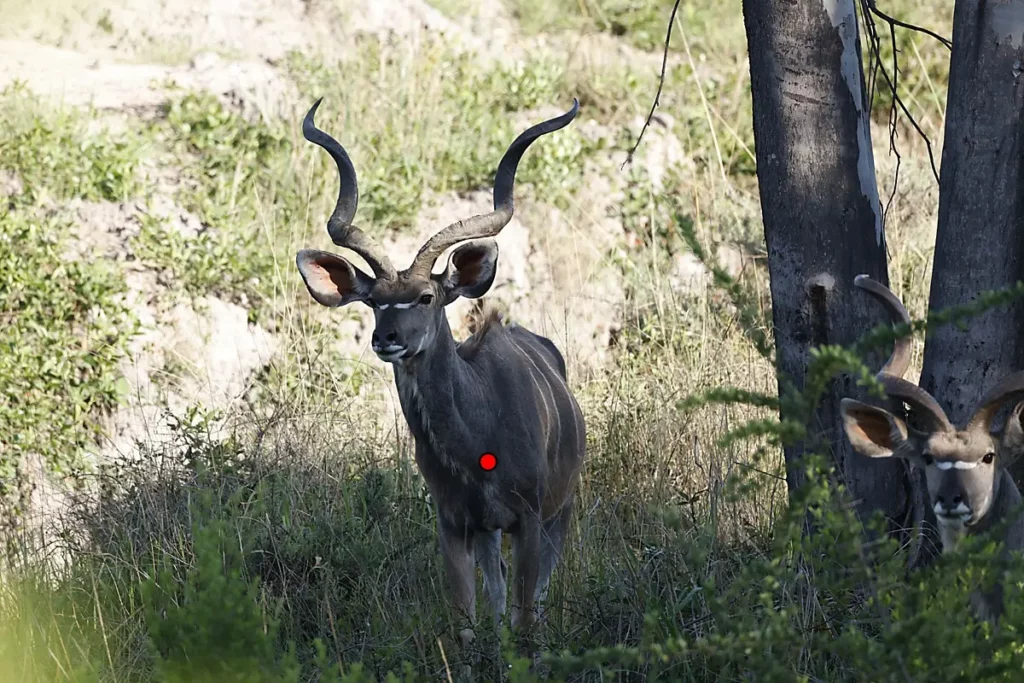
Conservation of the Environment
Responsible hunting practices involve respecting the bushveld and minimizing our impact on the environment.
Ultimately, an ethical shot is a reflection of a hunter’s commitment to good hunting. Striving for the highest standards of responsibility, respect, and compassion is not just an expectation; it’s a fundamental aspect of the hunting community’s ethos. By adhering to these principles, hunters can enjoy their pursuit while contributing to the preservation of wildlife and their habitats.
Conclusion
In this comprehensive guide, we’ve looked into the critical subject of where to shoot when hunting a good kudu in South Africa. These key points discussed have emphasized the profound significance of your shot for an ethical and successful African hunting Safari. This advice can also be applied to other plains game like Impala, Bushbuck, Gemsbok, Nyala, Blue Wildebeest and Zebra.
FAQ’s Frequently Asked Questions
Where is the best destination for a kudu Safari?
South Africa, as it is home to the largest population of kudu. Other countries in southern Africa, such as Namibia, Zimbabwe, and Botswana, also offer kudu safaris.
What is the best time of year for kudu?
The best time for kudu is during the dry season, which typically runs from May to September in Southern Africa. During this time, the vegetation is less dense, making it easier to spot and track kudu.
What cartridge is recommended for kudu?
The recommended cartridge for kudu is typically the .30-06 or larger. This caliber provides sufficient power and range for an ethical and effective shot on a kudu.
What is a herd?
A herd is a group of kudu or other animals that live and move together. Kudu are typically found in small herds consisting of cows and calves, while adult bulls are often solitary or form bachelor groups.
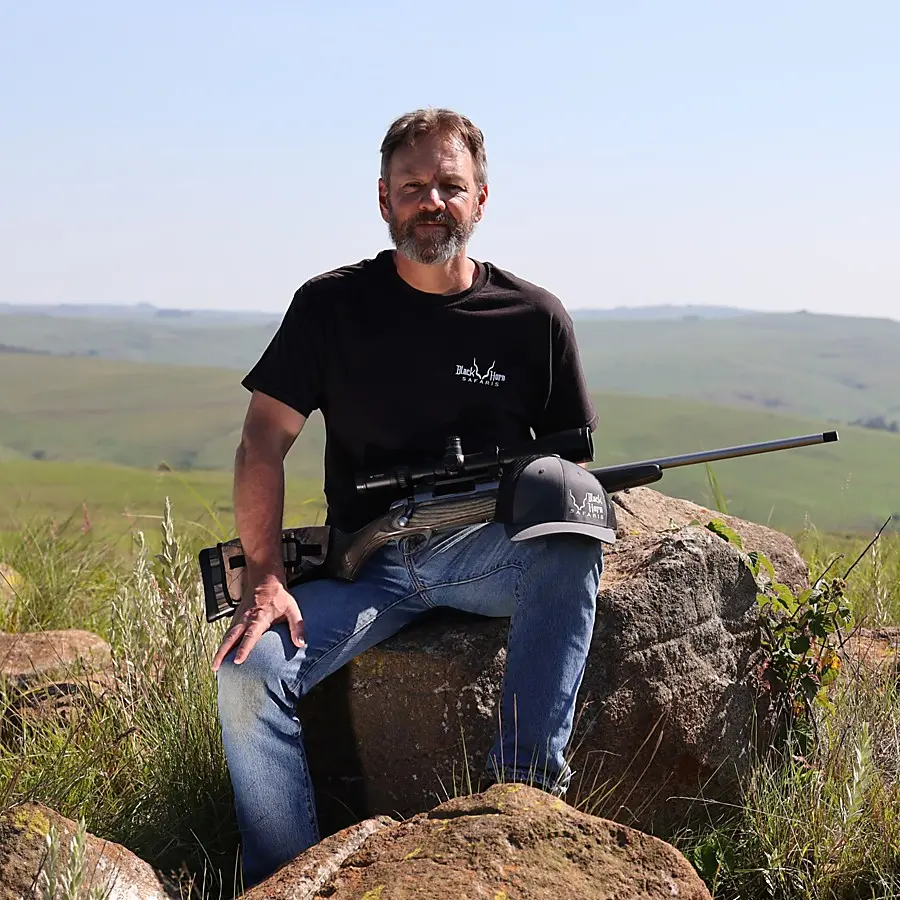
Adrian Anderson first obtained his Professional Hunters license in 1991. He is a Big Five and Dangerous Game licensed Professional Hunter and Hunting Outfitter. He has a tremendous love for wildlife and the African bush and enjoys sharing his knowledge with the hunting clients that he guides. Guiding hunters in Africa’s wild places is a passion and seeing them succeed with their goals brings satisfaction. With knowledge of the Safari industry built up over 32 years he is well qualified to give guidance to his hunting clients.
